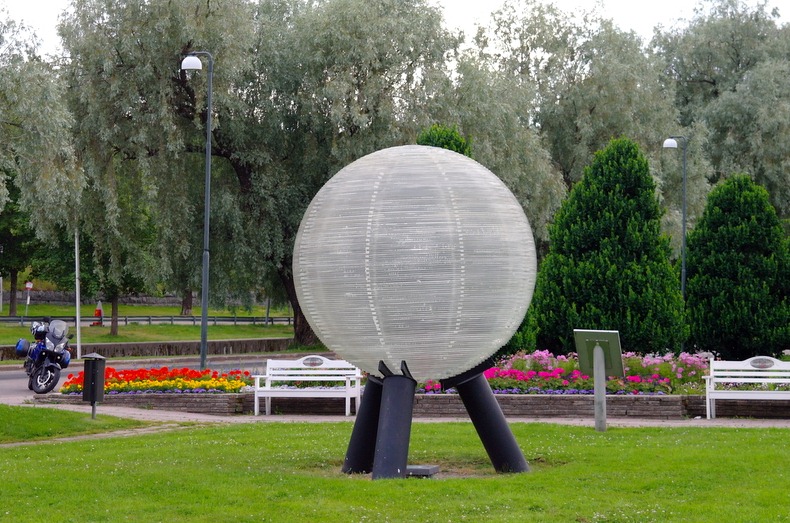The Sweden Solar System is the world's largest model of our planetary system, built at a scale of 1:20 million and stretches the entire length of the country. The Sun is represented by the Globe arena in Stockholm, the largest spherical building in the world. The planets are placed and sized according to scale with the inner planets being in Stockholm and Jupiter at the International airport Arlanda. The outer planets follow in the same direction with Saturn in Uppsala and Pluto in Delsbo, 300 km from the Globe. The model ends at the Termination shock, 950 km from the Sun.
At each planet station, exhibits provide information about astronomy and the natural sciences, and also about related mythology and culture. The Stockholm Visitor's Board (former Stockholm Information Service) was a sponsor of the project in the beginning, like several museums, theaters, parks and scientific institutions.
The Sun represented by the Ericsson Globe, in Stockholm, is 110 m in diameter. To respect the scale, the globe represents the Sun including corona.
Mercury (25 cm in diameter) is placed at Stockholm City Museum, 2,900 m from the Globe.
Venus (62 cm in diameter) is placed at KTH (Royal Institute of Technology), 5,500 m from the Globe. The model, made by the US artist Daniel Oberti, was inaugurated June 8, 2004, during a Venus transit. The model fell and shattered around June 11, 2011. There is another model of Venus located at the Observatory Museum.
Earth (65 cm in diameter) is located at the Swedish Museum of Natural History (Cosmonova), 7,600 m from the Globe. Satellite images of the Earth are exhibited beside the Globe.
An elaborate model of the Moon (18 cm in diameter) is on display in another part of the museum.
Mars (35 cm in diameter) is located at Mörby Centrum, a shopping centre in Danderyd, a suburb of Stockholm. It is 11.6 km from the Globe. The model, made in copper by the Finnish artist Heikki Haapanen is connected by a "umbilical cord" to a steel plate on the floor having an Earth image. The globe also features marks that represent some typical martian chemical elements.
Jupiter (7.3 m in diameter) is placed at the roundabout near Sky City, in Stockholm's large airport Arlanda 40 km from the Globe. Made as a flower decoration, with different flowers representing different zones of the giant gas planet; however, there are plans to build a 3D model.
Saturn (6.1 m in diameter) is placed outside the old observatory of Anders Celsius, in the so-called Celsius Square, at centre of Uppsala, 73 km from the Globe. [Picture not available]
Uranus (2.6 m in diameter) was vandalized and the new model is planned to some place in Gävle, 143 km from the Globe. [Picture not available]

Neptune (2.5 m in diameter) is located by the river Söderhamnsån in Söderhamn, a coast town with tradition in fishing and sailing (which relates to Neptune as the deity of the seas). Placed 229 km from the Globe, the model is made of acrylic and, at night, shines with a blue light.
Pluto (12 cm in diameter) and its moon Charon are placed near the southern of the Dellen lakes, in Delsbo, 300 km from the Globe. The lakes are thought to be formed by a meteorite impact 90 million years ago. The two bodies' sculptures are supported by two gravelike pillars (as Pluto being the deity for death), made up with dellenite, a rare mineral formed at that place by the meteorite impact.
The Terminal Shock is the edge of heliosphere, the farthest place where the solar wind goes in supersonic velocity. No sculpture currently represents the terminal shock, but a foundation for a future sculpture exists at the Institute of Space Physics, 950 km from the Globe, in Kiruna, above the Arctic Circle.























Hi, live Uppsala but didn't know Saturn is here. See if I can fix a picture.
ReplyDeleteThank you mattiasw. I would really appreciate a picture.
ReplyDeleteLate to the game, but I posted on it http://artstoryhumor.wordpress.com/2013/01/11/it-could-have-been-worse/ thanks for the heads up on this one.
ReplyDeleteThis is a great idea! THere is one in Melbourne (Australia), but on a much smaller, walkable scale.
ReplyDeleteThey even incuded some comets! I don't see the Asteroid Belt, tho'. And what about the fact that because of its extremely elliptical orbit, there are times when Neptune is farther from Sol (the sun) than Pluto? They did respect Node's law... (Sorry... Math/Physics/Astrophysics major, here...)
ReplyDeleteNice to see a country that is not in collapse but doing things like this that support both science and communities.
ReplyDeleteI would love to use this scale model as background for a trip to Sweden with my two Solar System loving grandkids.
ReplyDelete